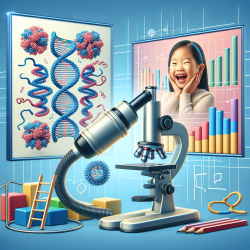As a speech-language pathologist, you strive to provide the best care for your pediatric patients. Staying updated with the latest research can be pivotal in enhancing your clinical practice. One such research article, "Relationship Between Patients with Clinical Auditory Neuropathy Spectrum Disorder and Mutations in Gjb2 Gene," provides valuable insights into the genetic underpinnings of Auditory Neuropathy Spectrum Disorder (ANSD).
ANSD is a condition characterized by the loss of synchrony in the auditory pathway, leading to deficits in nerve conduction within the auditory nerve fibers. This can result in various degrees of hearing loss, which is particularly challenging for children as it impacts their speech and language development.
Key Findings from the Research
- Mutations in the GJB2 gene were found in 7.5% of patients with ANSD.
- Most patients exhibited congenital onset of symptoms, with 75% showing signs within the first year of life.
- The presence of otoacoustic emissions (OAEs) with absent or abnormal auditory brainstem response (ABR) was noted in 47.5% of cases.
While the study found no significant relationship between ANSD and GJB2 gene mutations (p>0.05), it highlighted the need for further research. The findings suggest that genetic testing, combined with clinical and audiological exams, can lead to more accurate diagnoses and better-targeted interventions.
Clinical Implications
As practitioners, integrating genetic testing into your diagnostic toolkit can be transformative. Here are some actionable steps:
- Incorporate Genetic Testing: Advocate for genetic testing in cases of unexplained hearing loss to identify potential mutations in the GJB2 gene and other relevant genes.
- Comprehensive Evaluations: Use a combination of ABR, OAEs, and cochlear microphonic (CM) tests to diagnose ANSD accurately.
- Collaborative Approach: Work closely with geneticists, audiologists, and otolaryngologists to provide a multidisciplinary approach to diagnosis and treatment.
By adopting these strategies, you can enhance your diagnostic accuracy and provide more personalized treatment plans for your pediatric patients.
Encouraging Further Research
The research underscores the need for continued investigation into the genetic factors contributing to ANSD. As a practitioner, you can play a crucial role in this by:
- Participating in Research: Collaborate with research institutions to contribute clinical data that can help in understanding the genetic basis of ANSD.
- Staying Informed: Regularly review the latest research to stay updated on new findings and emerging trends.
- Advocating for Funding: Advocate for funding and support for genetic research in auditory neuropathy spectrum disorders.
By staying engaged with the research community, you can help pave the way for new discoveries and improved outcomes for children with ANSD.
To read the original research paper, please follow this link: Relationship Between Patients with Clinical Auditory Neuropathy Spectrum Disorder and Mutations in Gjb2 Gene.










